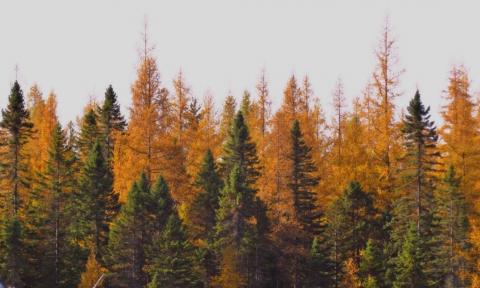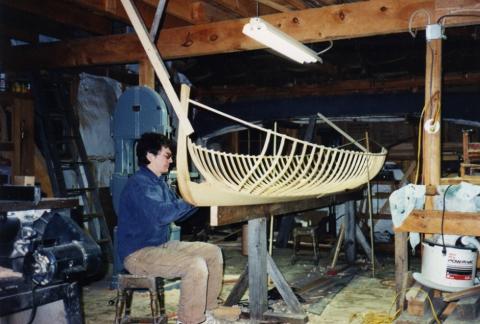A Tamarack Story

Tamarack trees are known for their beauty in the wild and as a landscaping conifer that changes with the seasons. Their soft golden glow in the fall catches your gaze and, in the spring, they have bright green needles with young female cones that start off as small purple flowers. Its lumber is used for outdoor applications where it lasts for some time as posts or decking and outdoor furniture.
Another important use that I find special is as knees in boatbuilding. The tree grows in cold northern swamps making it easier to pull the large roots from the loose soil once the tree is cut. Over history some loggers and sawyers made extra money by getting these stumps out of the swamps and sawn into knees that were used in wooden boats large and small. The grain will follow the curves needed for ribs or stems in Adirondack guideboats, canoes, and the ceiling knees on large ships.

Adirondack guide boat frame with hackmatack (also known as tamarack) knees cut to shape for ribs and stems.
Many of the small boats made by Old Town Canoe Co. before the 1950’s had hackmatack, as it’s called in Maine, for the transom and seat knees. The wood is fairly light, smooth to the touch, and has a nice blond color. It is also full of resin which makes it very long lasting and it’s hard enough to hold fastening well.
The story here starts with the fact that there was a record of a tamarack in the NH Big Tree Program that was close in size to the measurements of the national champion for that species. It had not been located or measured for many years, so the then Coos county forester Brendan Prusik, the recently retired Coos forester Sam Stoddard, and I searched a vast swamp area off of Bog Brook near the Androscoggin River to see if it could be located. After much traipsing around following moose trails in the knee-deep wet bog, we found several large standing dead tamaracks (American larch) and decided it was likely one of those. On the way out we found a smaller one and declared it the new county champion for that species, but it was not close to the size of the national champion.
A year or so later Karen Zale from upstate Vermont contacted me about restoring her father’s canoe. She mentioned that its name was Tamarack. I got back to her and let her know that I would be able to do the work on the canoe and thought it was interesting that they named the canoe Tamarack because I had been searching for a large tree of that type in NH. A long return e-mail came back about how they had used the canoe when children, and how her father had loved the tamarack tree. She had also attached a several page story of her father John Zale.
It told about his life in the military as a WW2 POW who had survived the Bataan Death March when imprisoned in the Philippines. Afterwards, he was aboard what were called the “Hell Ships” that transported them to a prison camp. While en-route, Allied battleships had fired upon and sunk some of the enemy ships, not knowing the prisoners were on board. Conditions aboard were very bad during that 30-day journey with over a thousand men jammed into a hold made for 200. Many died but John survived, making it to Japanese-controlled Manchuria in Northeastern China. Once at the POW camp there they suffered more, with 200 of the camp’s 1400 prisoners dying during the first winter. The following three years of their stay consisted of torture and harsh treatment until the war came to an end. After the war he came back to Vermont where, after some trouble adjusting to civilian life, John started a family and eventually became a boy scout leader who for many years taught the scouts the art of survival, earning wide respect among them.
Karen’s father had passed a year earlier and she decided to try to raise the money to restore the canoe. I said I could start things rolling by knocking off some of the cost to do the work. She then contacted some of the former scouts who are now prominent businessmen and civic leaders. Without hesitation they came up with the rest of the funds and I was able to restore the canoe to its former glory. It was only fitting that the decks of the canoe turned out to be made of tamarack and that name was repainted on the sides along with his POW #. The “Tamarack” is now hanging in a scout lodge in Buffalo NY. Karen spent the next year or so writing a book about her father called The Will to Survive that is available online and through bookstores.

Karen standing with the restored Tamarack canoe
Not long after restoring the canoe I helped lead a walk in Hemenway State Forest with other Big Tree Program members to see the largest pine in NH. Someone attending let us know there was a large tamarack on her property in Tamworth that should be measured. It did not take much convincing to get us over there, where we spent a few hours taking the measurements while admiring her tree. When adding up the circumference, height, and crown spread, the total points turned out to be the state champion for that species and just 6 points lower than the national champion. At the time, trees within 5 points of each other were considered a tie. Needless to say, we took a few more measuring trips to that tree but could never come up with that additional point to make it a national champ.
We submitted it to American Forests as a national competitor and low and behold the following year the other champion tree had died and the NH tree was designated the national champ. We were quite happy with the designation, even though it was short lived because a larger tree was listed in Wisconsin the following year. The NH Big Tree Program has a saying, “Once a champion, always a champion”. So even though the tamarack is not a national champion now, it has a special place in my mind as a significant tree in the northeast and this story shows how connections with people and trees live on in many different ways.
Kevin Martin is an expert wooden boat and canoe maker, Rockingham County Coordinator for the NH Big Tree program, and UNH Extension NH Big Tree volunteer. His first book, Big Trees of New Hampshire, directs readers on 28 hikes to find 85 of the largest trees that are on public land or in the cities where the public can see them up close.